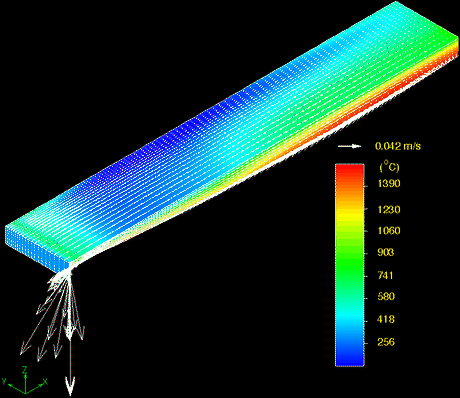|
Behavior of Top Surface Layers
Robert McDavid and Brian Thomas
Continuous Casting Consortium
A 3-D finite-element model of heat transfer and fluid flow has been developed of the top surface of the continuous caster to predict the thickness and behavior of the powder and flux layers. Mold powder melts to form a protective flux layer on the top surface of the steel, which helps to trap impurities and inclusions. Results indicate that the thickness of the beneficial liquid layer is highly non-uniform. Detrimental solid inclusions due to surface turbulence are most likely in the thinnest regions, whose locations have been successfully predicted by the model. Mold flow conditions, which are affected by the inlet nozzle geometry, are found to control this layer and are being investigated.

This figure shows the velocity vectors and temperature contours in the molten flux pool. Flux is consumed into the gap at the bottom of the narrow face (lower left) and into the wideface (top). The flow of steel along the bottom interface can be seen to drag liquid flux towards the submerged entry nozzle at the center of the mold (upper right). Flow recirculation drags powder back along the top surface towards the narrow face. There is a thin region in the molten flux layer just off the narrow face, due to the flow separation.
Publications:
McDavid, R., and B.G. Thomas, "Flow and Thermal Behavior of the Top Surface Flux / Powder Layers in Continuous Casting Molds", Metallurgical and Materials Transactions B, Vol. 27B, No. 4 (August), 1996, pp. 672-685; [Marcus A. Grossmann Award, 1997, ASM International, and Extraction and Processing Technology Award, 1998, TMS]. Click here for a PDF version. (2.35 MB)
|

